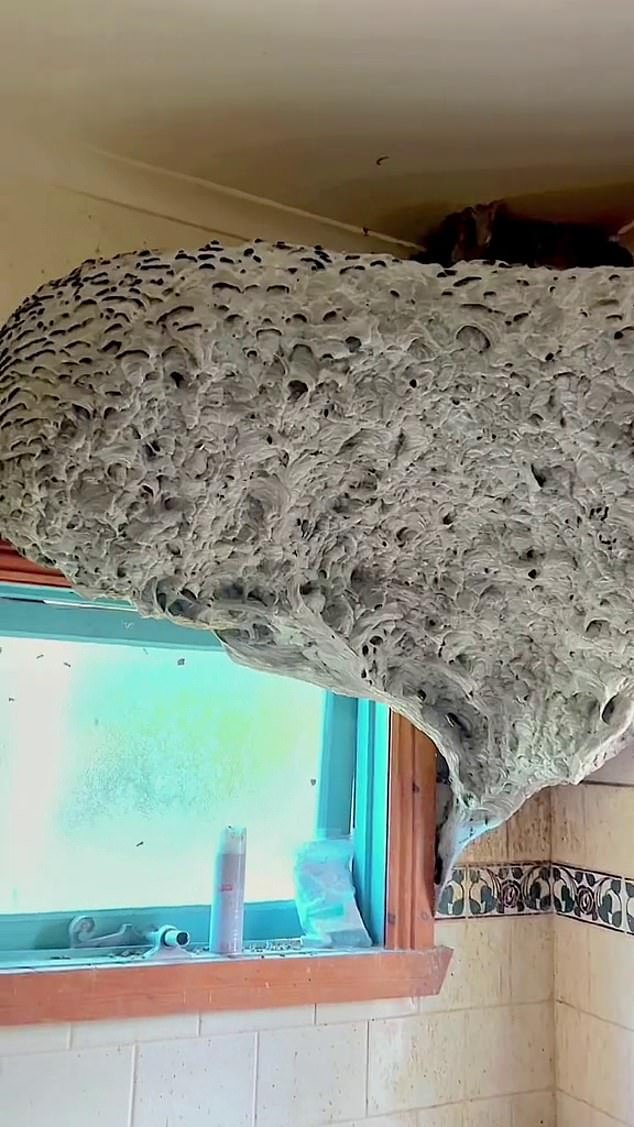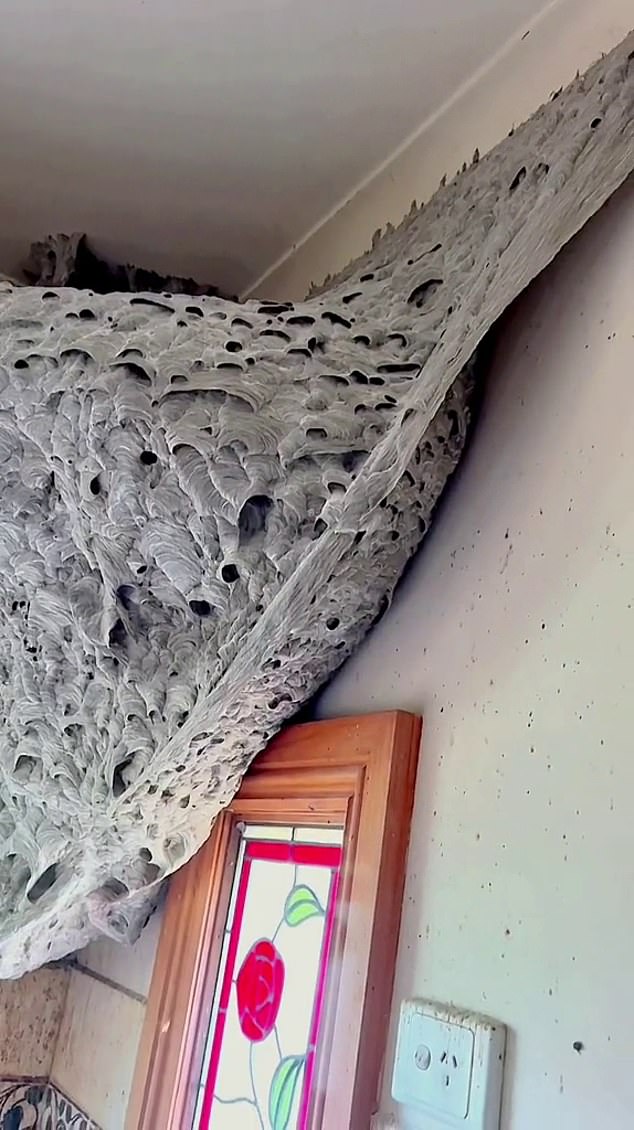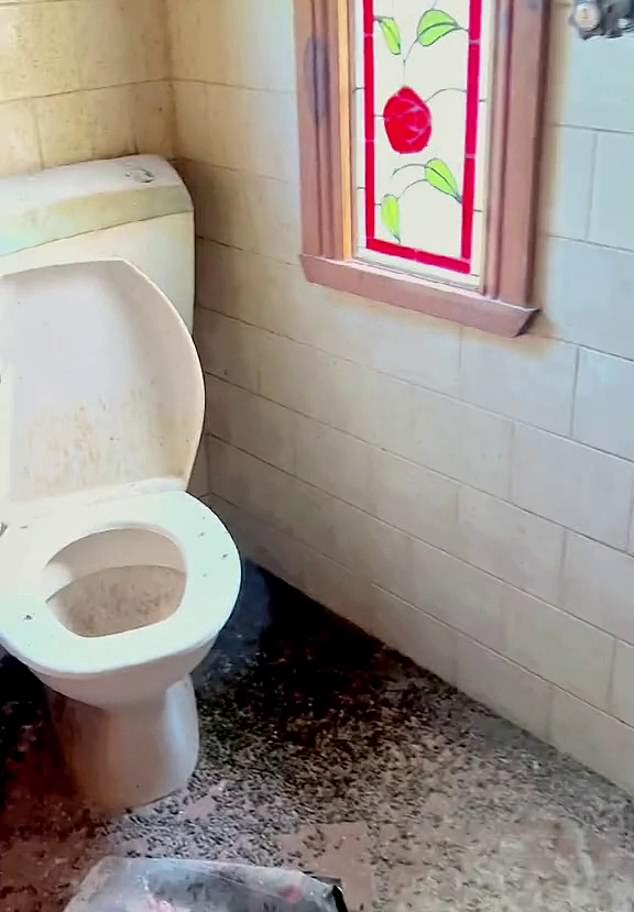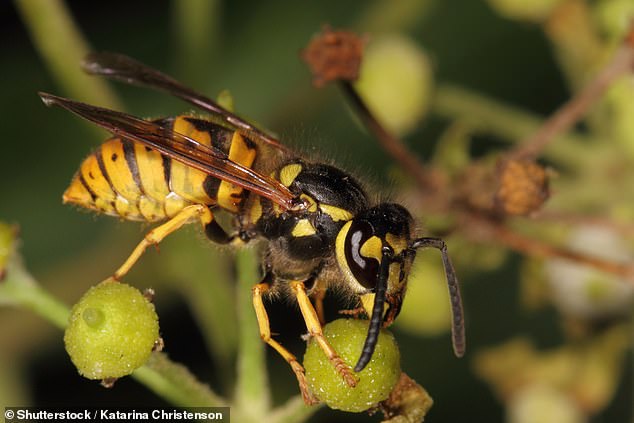Massive wasps’ nest inside Healesville house in Melbourne the ‘largest I’ve ever seen’, expert said
>
A deadly hornet’s nest has been found inside an abandoned house with images of the massive ’empire’ hanging over a toilet bowl going viral.
The pests’ hideout was discovered in a Healesville house 50km north of Melbourne and one alarmed expert called it “the biggest” he had ever found in the country.
The vision of the colossal nest was posted on social media this month by Dale Armel of DAP Pest Control, who was called in to deal with the issue.
The pests’ hideout (pictured above) was discovered in a Healesville house 50km north of Melbourne and one expert called it “the biggest” he has ever found in the country.
Images were seen of the gray mass measuring one by 1.5 meters suspended from the ceiling of a bathroom with wasps hovering around it.
It showed a toilet under the hanging sink with thousands of dead wasps on the floor of the dilapidated house.
Armel said the nest full of carnivorous wasps was huge and deadly.
“This is the largest European hornet nest I have come across in my pest control career,” he said on social media.
“This was a very dangerous situation – if any person or child came across this nest, they could have been swarmed and repeatedly stung.”
‘[It] it had to be removed as soon as possible to ensure everyone’s safety.
The seasoned pest controller said that despite his experience eradicating vermin throughout his career, this job scared him.
He said he was attacked by the pests while it took three days to remove the nest.

The seasoned pest controller said that despite his experience eradicating vermin throughout his career, this job (pictured) scared him.

The pest eradicator said the nest in the abandoned house (pictured) harbored “thousands and thousands” of wasps over the months.
“The wasps are attracted to carbon dioxide in the breath, which they register as a threat, and they attack,” he said. news.com.au.
He said The nest had been growing since at least September 2021 when it was discovered to resemble a basketball.
Armel added that it was home to “thousands and thousands” of insects over the months.
The large size and warmer inland location meant that it was a multi-seasonal nest that could have supported a continued population expansion.
The insects were able to keep warm inside, so the queens probably hibernated inside the nest.
“That means they could start laying and hatching new eggs right after spring, so we’re talking about an absolutely huge population with no break in how much it can expand.”

It showed a toilet under the sink with thousands of dead wasps on the floor and the bathroom sink in the dilapidated house.
Wasps, which feast on other insects, can be aggressive toward humans when they nest and forage for food near homes.
They are known to be a destructive and invasive pest in Australia, but are a protected species in the Northern Hemisphere.
‘Usually, this species builds its nest underground, so to see the detail of this [one] it’s really amazing, a once in a lifetime opportunity’, he said on social media.
Armel was able to film the extraordinary footage up close because he had exterminated the vast majority of the wasps the previous week.
But there were stages of the extermination that left a number of stray insects buzzing around on video.
“I don’t recommend anyone go near a nest of any size unless they are a trained professional,” he added.
European wasps build their homes out of organic matter, first building an inner layer of honeycomb to support their larvae.

European wasps are known to be a destructive and invasive pest in Australia, but are a protected species in the northern hemisphere.
They then make the outer shell seen in the striking images using a mixture of saliva and wood fibers.
Insects create holes for entry and exit points and for ventilation.
The post of the creatures inside the house went viral on social media with some fascinated by the nest building.
‘I’m not a fan of wasps, but I do admire the engineering of their nests. This is a work of art,” said one commenter.
‘It really is amazing,’ said another, while the post led another to ask: ‘What if bro needs to go to the bathroom?’
But others were frightened by the mammoth nest, comparing it to a ‘Resident evil 7 house’.
‘Is that the wasp equivalent to the Roman Empire?’ another online user asked about the nest.
